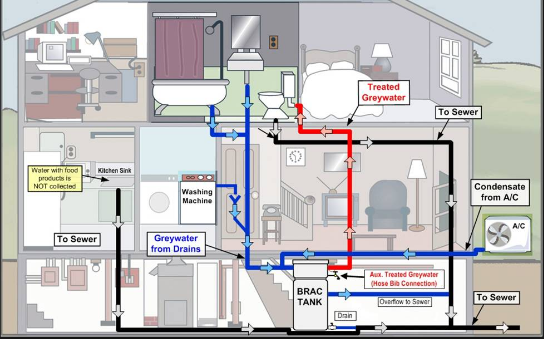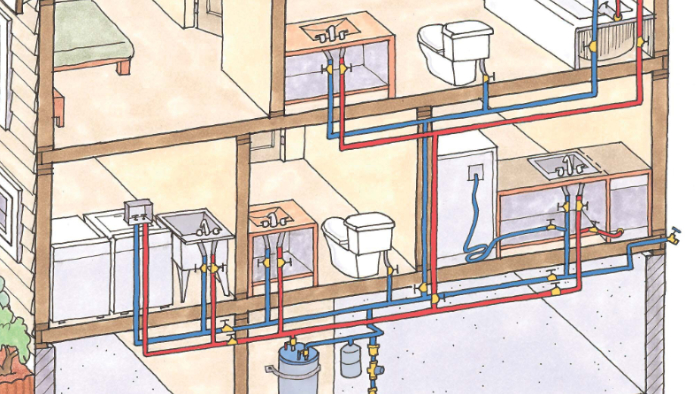How The Structure of Your House's Plumbing System Matters
How The Structure of Your House's Plumbing System Matters
Blog Article
How do you feel about Plumbing Installation 101: All You Need to Know?

Understanding exactly how your home's plumbing system functions is crucial for every single homeowner. From providing clean water for alcohol consumption, cooking, and showering to securely getting rid of wastewater, a properly maintained plumbing system is crucial for your family members's health and wellness and comfort. In this extensive guide, we'll discover the complex network that makes up your home's pipes and offer tips on maintenance, upgrades, and taking care of typical issues.
Intro
Your home's plumbing system is more than simply a network of pipelines; it's a complicated system that ensures you have accessibility to clean water and reliable wastewater removal. Understanding its parts and how they work together can assist you protect against costly repair services and guarantee every little thing runs smoothly.
Fundamental Components of a Pipes System
Pipelines and Tubing
At the heart of your plumbing system are the pipelines and tubes that carry water throughout your home. These can be made from numerous products such as copper, PVC, or PEX, each with its benefits in terms of sturdiness and cost-effectiveness.
Fixtures: Sinks, Toilets, Showers, and so on.
Components like sinks, toilets, showers, and tubs are where water is used in your home. Comprehending just how these fixtures connect to the plumbing system helps in identifying troubles and intending upgrades.
Valves and Shut-off Points
Valves manage the circulation of water in your pipes system. Shut-off valves are crucial during emergencies or when you require to make repair services, permitting you to isolate parts of the system without disrupting water circulation to the whole residence.
Water Supply System
Main Water Line
The main water line links your home to the community water system or an exclusive well. It's where water enters your home and is dispersed to different components.
Water Meter and Stress Regulatory Authority
The water meter actions your water usage, while a stress regulatory authority makes sure that water moves at a secure stress throughout your home's pipes system, protecting against damages to pipelines and fixtures.
Cold Water vs. Hot Water Lines
Recognizing the distinction between cold water lines, which provide water straight from the primary, and hot water lines, which lug warmed water from the water heater, aids in troubleshooting and preparing for upgrades.
Drain System
Drain Pipes Pipes and Traps
Drain pipes lug wastewater away from sinks, showers, and bathrooms to the sewage system or septic tank. Traps stop sewer gases from entering your home and additionally trap particles that might cause obstructions.
Air flow Pipes
Air flow pipes allow air into the drainage system, avoiding suction that could slow drainage and cause catches to vacant. Correct ventilation is important for preserving the honesty of your plumbing system.
Significance of Appropriate Water Drainage
Ensuring appropriate drain protects against back-ups and water damages. Regularly cleaning drains pipes and preserving catches can avoid pricey repairs and prolong the life of your pipes system.
Water Heating System
Kinds Of Hot Water Heater
Water heaters can be tankless or standard tank-style. Tankless heaters heat water on demand, while storage tanks save heated water for prompt usage.
How Water Heaters Attach to the Plumbing System
Recognizing how hot water heater connect to both the cold water supply and warm water circulation lines aids in diagnosing problems like inadequate warm water or leaks.
Upkeep Tips for Water Heaters
Routinely flushing your hot water heater to remove sediment, examining the temperature setups, and inspecting for leakages can expand its life expectancy and boost energy effectiveness.
Typical Pipes Issues
Leakages and Their Reasons
Leaks can happen because of maturing pipelines, loosened installations, or high water pressure. Addressing leakages promptly prevents water damage and mold growth.
Clogs and Blockages
Clogs in drains and commodes are often caused by flushing non-flushable items or a buildup of grease and hair. Using drain screens and being mindful of what drops your drains pipes can protect against obstructions.
Indicators of Pipes Troubles to Expect
Low water pressure, slow drains, foul odors, or unusually high water bills are indications of prospective plumbing problems that should be resolved immediately.
Pipes Maintenance Tips
Regular Examinations and Checks
Set up annual plumbing evaluations to catch issues early. Search for indications of leakages, rust, or mineral build-up in taps and showerheads.
Do It Yourself Maintenance Tasks
Basic jobs like cleansing tap aerators, checking for toilet leaks using dye tablets, or insulating exposed pipes in cold climates can prevent major plumbing concerns.
When to Call a Specialist Plumbing Professional
Know when a pipes concern needs expert knowledge. Attempting complex repair work without proper knowledge can bring about even more damage and greater fixing prices.
Upgrading Your Plumbing System
Factors for Updating
Updating to water-efficient fixtures or replacing old pipes can improve water quality, minimize water expenses, and enhance the value of your home.
Modern Pipes Technologies and Their Advantages
Explore technologies like clever leakage detectors, water-saving bathrooms, and energy-efficient water heaters that can save cash and decrease environmental influence.
Price Factors To Consider and ROI
Calculate the upfront prices versus long-lasting cost savings when considering pipes upgrades. Lots of upgrades pay for themselves via minimized utility bills and fewer repair services.
Environmental Influence and Preservation
Water-Saving Fixtures and Appliances
Installing low-flow faucets, showerheads, and commodes can substantially reduce water use without compromising efficiency.
Tips for Minimizing Water Usage
Easy habits like dealing with leaks promptly, taking much shorter showers, and running full lots of laundry and recipes can save water and lower your energy costs.
Eco-Friendly Plumbing Options
Take into consideration sustainable pipes materials like bamboo for flooring, which is durable and eco-friendly, or recycled glass for kitchen counters.
Emergency Readiness
Steps to Take Throughout a Plumbing Emergency situation
Know where your shut-off valves lie and exactly how to switch off the supply of water in case of a ruptured pipeline or significant leakage.
Importance of Having Emergency Situation Contacts Helpful
Maintain get in touch with details for local plumbings or emergency situation solutions readily available for quick action throughout a pipes situation.
Do It Yourself Emergency Fixes (When Appropriate).
Temporary fixes like utilizing air duct tape to spot a dripping pipeline or placing a bucket under a leaking faucet can lessen damages up until a professional plumbing shows up.
Verdict.
Recognizing the composition of your home's plumbing system equips you to preserve it effectively, saving time and money on repairs. By following regular maintenance routines and staying informed regarding contemporary plumbing technologies, you can guarantee your pipes system runs effectively for years to come.
HOW YOUR PLUMBING SYSTEM WORKS
Which Pipes Do What?
Blue lines = fresh water supply entering the building
Red lines = hot water supply entering the building
Grey lines = pipes carrying waste away from the building and venting pipes carrying gases away from the building (through the roof)
YOUR MAIN PLUMBING SYSTEMS
There are two main plumbing systems that support your home s basic plumbing needs one that brings clean water into your home, and one that sends dirty water away from your home. Connected to the toilet, bath, shower, and other faucets in your home, these two systems keep your water flowing in the right directions.
ACCESSING FRESH WATER
Fresh and clean water is brought into your home through the main water supply line . Filtered through one pipe, this water is pressured to flow into the various fixtures in your home at any given time.
This water can be sourced from a well located on your property, a pond or river (mostly cottages), or, as in most cases, from the city s municipal water treatment centre. However, it is important to note that water that is untreated, such as the water siphoned from ponds or rivers, may not be safe to drink. Personal water supplies always need to be treated for hardness and contaminants before consumed.
MUNICIPAL WATER SUPPLIES
Improve taste and odour
Remove sediment
Eliminate hardness
Reduce chlorine
COLD WATER SUPPLY VS. HOT WATER SUPPLY
Cold water flows into your home or building through the service line, which then distributes hot or cold water to your fixtures. This line is most commonly run through a central column that runs floor to floor. Hot water runs in short and straight pipes as the longer the pipeline, the more heat that will be lost in the transfer. Having shorter pipes also allows residents to access hot water more quickly.
WASTE WATER SYSTEM
Your wastewater system is divided into two parts pipes that send wastewater away from your home and venting pipes that send sewer gas away from your home. Sewage water travels through pipes that flush the water and waste towards local sewers that are operated and managed by your city or town. Most sewer systems rely on gravity to move the wastewater to where it needs to go.
The further away from your toilet or sink, the larger wastewater pipes become. This allows for waste to be disposed of from various parts of your home or business at once without pipe blockages. The angle and flow of these pipes are also essential for keeping your waste pipes clear of build up.
https://harrisplumbing.ca/how-your-home-plumbing-system-works/

HOW YOUR PLUMBING SYSTEM WORKS
Which Pipes Do What?
YOUR MAIN PLUMBING SYSTEMS
There are two main plumbing systems that support your home s basic plumbing needs one that brings clean water into your home, and one that sends dirty water away from your home. Connected to the toilet, bath, shower, and other faucets in your home, these two systems keep your water flowing in the right directions.
ACCESSING FRESH WATER
Fresh and clean water is brought into your home through the main water supply line . Filtered through one pipe, this water is pressured to flow into the various fixtures in your home at any given time.
This water can be sourced from a well located on your property, a pond or river (mostly cottages), or, as in most cases, from the city s municipal water treatment centre. However, it is important to note that water that is untreated, such as the water siphoned from ponds or rivers, may not be safe to drink. Personal water supplies always need to be treated for hardness and contaminants before consumed.
MUNICIPAL WATER SUPPLIES
COLD WATER SUPPLY VS. HOT WATER SUPPLY
Cold water flows into your home or building through the service line, which then distributes hot or cold water to your fixtures. This line is most commonly run through a central column that runs floor to floor. Hot water runs in short and straight pipes as the longer the pipeline, the more heat that will be lost in the transfer. Having shorter pipes also allows residents to access hot water more quickly.
WASTE WATER SYSTEM
Your wastewater system is divided into two parts pipes that send wastewater away from your home and venting pipes that send sewer gas away from your home. Sewage water travels through pipes that flush the water and waste towards local sewers that are operated and managed by your city or town. Most sewer systems rely on gravity to move the wastewater to where it needs to go.
The further away from your toilet or sink, the larger wastewater pipes become. This allows for waste to be disposed of from various parts of your home or business at once without pipe blockages. The angle and flow of these pipes are also essential for keeping your waste pipes clear of build up.
https://harrisplumbing.ca/how-your-home-plumbing-system-works/
As a passionate person who reads about The Inner Workings of Your Home's Plumbing, I thought sharing that portion was really helpful. I beg you pause to share this write-up if you liked it. Thanks for your time. Revisit us soon.
Booking Report this page